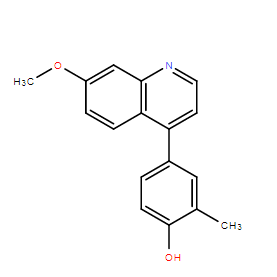| Cas No.: | 2165340-32-7 |
| Chemical Name: | 4-(7-methoxyquinolin-4-yl)-2-methylphenol |
| SMILES: | C(C1=CC=NC2C=C(OC)C=CC1=2)1=CC=C(O)C(C)=C1 |
| Formula: | C17H15NO2 |
| M.Wt: | 265.31 |
| Purity: | >98% |
| Sotrage: | 2 years -20°C Powder, 2 weeks 4°C in DMSO, 6 months -80°C in DMSO |
| Description: | CU-CPT-9a is a specific TLR8 antagonist, with an IC50 of 0.5 nM. |
| Target: | TLR8:0.5 nM (IC50) |
| In Vitro: | CU-CPT-9a is a specific TLR8 antagonist, with an IC50 of 0.5±0.1 nM. The elevation of the downstream protein levels induced by R848 can be reversed by CU-CPT-9a in a dose-dependent manner. By contrast, the expression of TRIF and IRF3 (cytoplasmic and nuclear) are only responsive to TLR4 and TLR3, independent of TLR837. The expression levels of TRIF and IRF3 do not show significant change in THP-1 cells upon treatment of R848, nor do they change with the treatment of CU-CPT-9a. CU-CPT8m and CU-CPT-9a both significantly suppress the TNF-α level in a dose-dependent manner, which is in agreement with previous reports of TLR8 involvement in these autoimmune diseases[1]. |
| References: | [1]. Zhang S, et al. Small-molecule inhibition of TLR8 through stabilization of its resting state. Nat Chem Biol. 2018 Jan;14(1):58-64. |

 DC Chemicals' products qualify for U.S. tariff exemptions. We guarantee no price increases due to customs duties and maintain stable supply, continuing to deliver reliable research solutions to our American clients.
DC Chemicals' products qualify for U.S. tariff exemptions. We guarantee no price increases due to customs duties and maintain stable supply, continuing to deliver reliable research solutions to our American clients.





















